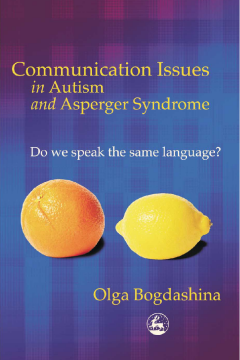
Additional Information
Book Details
Abstract
Providing a theoretical foundation for understanding communication and language impairments specific to autism, Olga Bogdashina explores the effects of different perceptual and cognitive styles on the communication and language development of autistic children. She stresses the importance of identifying each autistic individual's nonverbal language - which can be visual, tactile, kinaesthetic, auditory, olfactory or gustatory - with a view to establish a shared means of verbal communication. She offers an explanation of why certain approaches, for example PECS, might work with some autistic children but not others. Offering real insights, the `What They Say' sections enable the reader to see through the eyes of autistic individuals and to understand their language differences first hand.
`What We Can Do to Help' sections throughout the book give practical recommendations on what to do in order to help autistic individuals use their natural mechanisms to learn and develop social and communicative skills. The final chapters are devoted to assessment and intervention issues with practical recommendations for selecting appropriate methods and techniques to enhance communication, based on the specific mode of communication a person uses.
Olga Bogdashina, MSc (Education), MA (Autism), PhD (Linguistics) has worked extensively in the field of autism as teacher, lecturer and researcher, with a particular interest in sensory-perceptual and communication problems in autism. Since 1994, she has been the director of the first Day Centre for autistic children in Ukraine and the President of the Autism Society, Ukraine. Olga teaches and lectures around the world. She is currently a Visiting Lecturer at Birmingham University and Consultant Psychologist for Services for Adults with Autism, Doncaster, UK. She has a teenage autistic son.
Bogdashina revises linguistic theories and normal child language development. The main discussion is that autistic people have a sensory language, whereas the rest of us have a linguistic one. She expands on how sensory perception difficulties affect learning. She reviews current popular interventions (PECS, signing, Lovaas). 'What they say' paragraphs are enlightening quotes from autistic people, an illustrations by autistic people make it very readable.
Speech and Language Therapy Practice
Bogdashina challenges our understanding of autism and what the artistic community needs from us. Rather than insisting that they meet us on our terms, she asserts that we should be ready to respect and meet theirs. No longer relying soley on our interpretations of their needs, this notion is reinforced by their own requests. This is certainly the strength of Bogdashina's book. Clearly written in approachable language, Bogdashina's book is certainly suitable for parents, educators and students, while still being penetrating enough for an academic audience as well.
Metapsychology
Another great book by Olga Bogdashina. This is not just a book about communication issues in Autism, it is a book about language, learning, intelligence and culture. It is open minded and thoughtful throughout, repeatedly emphasising the two way nature of communication and not just focussing on how to make autistic people do all the work like so many books do. The book is in three parts, the first looking mainly at theories of language and intelligence, the second at characteristics, learning styles and development in autism, and the third and final part examines strategies to enhance communication'.
Asperger Information.net
This book is to help professionals and parents to understand people with autism. The author views autistic individuals as having a different language and culture which we must interpret. She asks: `Why do we always think that it is us who have to teach autistic people? If we want to grow together, we have to learn from them.The 'What They Say' sections enables readers to see through the eyes of autistic individuals. The `What Can We Do To Help' sections give strategies to develop communication skills in autistic individuals. There are also many examples which show differences in perception, thinking, language and communication.
Home Education Advisory Service Bulletin
Table of Contents
| Section Title | Page | Action | Price |
|---|---|---|---|
| PART I: Introduction | |||
| Background report | |||
| Executive Summary | |||
| PART II: Background to the Somali war | |||
| Introduction to Somalia | |||
| The Somali civil war | |||
| Understanding the conflict | |||
| PART III: Mogadishu: Peace enforcement | |||
| The Internationalization of the Somali conflict | |||
| The politics of UNOSOM | |||
| District councils | |||
| Humanitarian issues - NGOs and UNOSOM | |||
| PART IV: Kismayo: Peace-making | |||
| Background to the Kismayo wars | |||
| The Kismayo peace conference | |||
| A fragile peace | |||
| Conclusions and Recommendations | |||
| PART V: Somaliland: Peace building | |||
| Secession and Cessation | |||
| The Boroma conference | |||
| Post-Boroma | |||
| Demobilization | |||
| The Sanaag Grand Peace Conference | |||
| Conclusions and Recommendations | |||
| POSTSCRIPT | |||
| NOTES | |||
| REFERENCES | |||
| APPENDICES | |||
| INDEX. |
